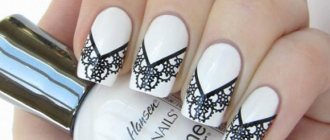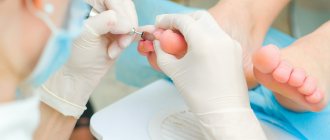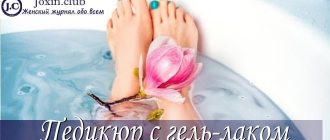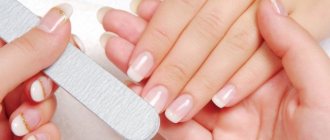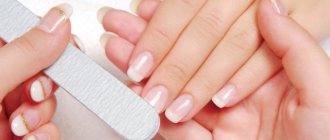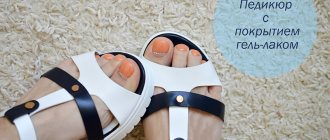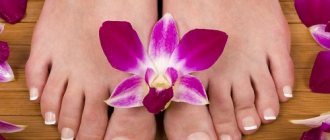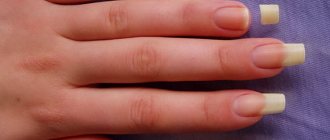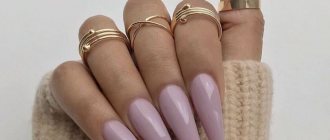Despite the fact that some people remember the need to get a pedicure only in the summer, when it is time to switch to open shoes and sandals, or before going to the beach, our feet need care no less than other parts of the body. Think about it: we spend most of the day on our feet, walking, running, our feet are constantly in need of shoes, and unlike in the summer, when we think of a pedicure because of the need to show off our legs, at any other time of the year our feet are almost constantly in closed shoes, often uncomfortable and not always new and clean. In such conditions, it is not surprising that the feet require special care, just like the hands: and while women usually do not regret spending a lot of time, effort and money on manicures, many people forget about pedicures.
Of course, for a pedicure it is not necessary to go to the salon and visit the specialist regularly: basic foot care procedures can be performed at home on your own. Most of the necessary manipulations do not require special skills or expensive products, and pedicures are sufficient once every 8-10 days.
Nail care
When applying the coating to the nail plate:
- For the first two days after a pedicure, do not visit a bathhouse or sauna with a lot of steam so that the coating does not peel off.
- Do not file your nails yourself - this should be done by a professional.
- Do not expose your nails to hot water for long periods of time.
- Avoid swimming in pools with chlorinated water, as it destroys the varnish coating and makes it dull (chlorinated water is also harmful to the skin and the whole body).
- Moisturize the cuticle with special oil.
- Make an appointment at the beauty center for correction in a timely manner.
If there is no coverage:
- Periodically make strengthening nail baths with sea salt and vegetable oils.
- Use a soft brush to massage the cuticle and nail plate, additionally use natural oils.
- Rub vitamin complexes into your nails - this will help get rid of brittleness, dryness, and unevenness of the nail plates.
- If you need to shorten the length, use a file (on dry nails); after the bath, trim the softened nails with manicure scissors.
- When cutting your nails yourself, do not touch the corners so as not to cause the nail to grow into the skin.
- If dirt gets under your nails, remove it with a wooden spatula and a brush - these tools are the safest for the health of your nails and skin.
- For proper nail care, contact a pedicurist.
Rules of care after pedicure
To prolong the effect of the procedure, you must follow seven simple but very important rules of care.
Special foot cream
You need to choose an evening foot cream for yourself and use it every day. It is recommended to use it every time after a shower on damp skin. If the application process takes place right before bed, it would be a good idea to wear cotton socks, then after waking up your heels and feet will be soft and tender.
Foot skin care
Cleansing
- Wash your feet several times a day - your feet get as dirty as other parts of your body.
- To wash, use warm water, soap or gel; When soaping your feet, do not forget about the space between your toes.
- Do not leave your washed feet wet, wipe them dry, especially carefully remove moisture between the toes - this will prevent the appearance of interdigital fungus.
Exfoliation
- While you shower, exfoliate dead skin cells with a foot file.
- Do not use rough pumice stones to exfoliate; the surface may scratch the skin.
- Scrub your skin once a week - buy a ready-made foot scrub or use sea salt or ground coffee as a scrub.
- To remove rough skin, take a softening bath, then use a file. You cannot cut off softened skin!
Nutrition
- Use a nourishing cream at night so that your skin is saturated with nutrients while you sleep. Apply the cream to your feet with massage movements until completely absorbed.
- Lubricate the skin around your nails with cuticle oil (you can use the same oil as for your hands).
- Once a week, make nourishing foot masks with clay, vitamins, and natural oils.
- In summer, choose creams with a lighter texture; in winter, choose products rich in oils.
Softening and moisturizing
- At the end of the working day, take relaxing baths with sea salt, decoctions of medicinal plants, and essential oils.
- Use creams with moisturizing and softening properties during the day and at night.
- If the skin on your feet is very dry, put on cotton socks after applying the cream - this will help the cream absorb better and make the skin softer.
- In the summer, use creams with cooling and deodorizing components (mint, menthol, tea tree extract) to relieve fatigue and avoid unpleasant foot odor.
How to get rid of a bunion forever: TOP 5 simple exercises
A bunion bothers many people. Doctors call it hallux valgus - deviation of the thumb from the outside. And although this is considered a cosmetic defect, many people who go to doctors with this problem experience discomfort and even pain when walking. How to get rid of a bunion and is it possible to do it yourself, told WMJ.ru.
Causes of bunions on the foot
A bulging bunion occurs in every fourth adult. But uncomfortable deviation of the finger occurs even in children and adolescents. Foot deformation is a consequence of the genetic characteristics of connective tissue. A large number of factors can provoke a negative tendency that will develop into hallux valgus:
- Overweight;
- Foot and leg injuries;
- Longitudinal flatfoot;
- Uncomfortable shoes;
- Changes in hormonal levels, including pregnancy.
The length and shape of the bones are of great importance in the formation of a protruding bunion on the leg. If they differ from the statistical average, then even with a normal ligament structure, the foot may become deformed over time.
Discomfort is the first signal of changes in the foot. At first, external deviations of the big toe are not noticeable, but when wearing shoes, discomfort and pain may be felt. Over time, the pain may intensify. The shape of the foot changes gradually: the big toe bone becomes pronounced, begins to protrude to the side, turns red and swells. The remaining toes begin to shift, and calluses and corns form.
Valery Kramar Neurologist and osteopath, chiropractor
— In fact, hallux valgus can be congenital or acquired. Weakness of connective tissue can be caused by a lack of vitamins, nutrients, diseases of the skeletal system, rickets, foot injuries and congenital injuries, hereditary factors, rapid growth and development in childhood, a sedentary lifestyle, and even incorrectly selected shoes that are not able to securely fix the foot.
An osteopathic doctor or surgeon can identify the problem through a visual examination. But to clarify the extent of the problem with a protruding bone, additional examinations will be required.
Exercises for bunions
If an examination by a doctor shows that the foot deformity is at an initial stage, in this case you can get by with therapeutic massage, physiotherapy and special accessories such as orthopedic insoles, interdigital pads and instep supports.

Photo: globallookpress.com © Nick White
There are special exercises that will help remove pressure in the foot, give it tone and elasticity. By doing them, you can prevent the development of a protruding bone and return it to its correct position.
- Exercise 1. Place your feet on the floor, spread your toes as wide as possible. Press your feet firmly to the floor. Then, without lifting your toes from the floor, try to shift your weight first to the outside, then to the inside of your foot. Do 10-12 reps.
- Exercise 2: Take a small plastic bottle of water. Step on it with the middle of your right foot. Roll the bottle 10-12 times. Repeat the same with your left leg.
- Exercise 3. Stand up straight. Place your right foot forward one step apart. Raise your foot slightly off the floor - about ten centimeters. Then, remaining in this position, pull the toe up and down 10-12 times. Repeat the same with your left leg.
- Exercise 4. Maintain the position from exercise 3 . But now pull your toe down, and then turn your foot to the right and pull your toe down again. Do the exercise also 10-12 times. Repeat the same with the other leg.
- Exercise 5. Maintain the position of the foot. Pull your toe down, then turn your foot to the left and pull your toe down 10-12 times. Repeat the same with the other leg.
There are advanced cases when only surgery can save the foot. Surgical intervention occurs in the case of chronic inflammation of the joints, severe displacement of the thumb and other fingers, severe pain and a change in the patient’s gait.
Pedicure correction by a specialist
Home foot care cannot replace a professional pedicure, so to ensure that your feet are always well-groomed, you need to visit a pedicurist once a month.
Benefits of a pedicure at a beauty center:
- Modern salons use hardware pedicure - a gentle and very effective method of caring for nails and skin of the feet.
- After the salon procedure there are no cuts, the skin on the feet grows more slowly.
- Hardware pedicure is suitable for thin and sensitive skin.
- The master will put your feet in order even in the most difficult cases; If the client has any diseases, he will offer a medical hardware pedicure.
- Pedicures are carried out according to a strict procedure and high-quality materials are used.
- The result of the work of a professional master lasts about a month; minimal maintenance effort required.
Pedicure: how to do it at home, step by step
In this instruction you will learn how to do a pedicure yourself at home and what is required for this. Every woman who has ever wondered how to properly do a pedicure understands that this procedure is associated not only and not so much with the use of nail polish, but with caring for the skin of the feet and nails in general. Therefore, for complete care you will need special products and tools, as well as a little practice, so that the result of a home pedicure is pleasing to the eye and maintains the health of your feet.
First of all, pedicure requires special tools. A standard pedicure set does not have to be too expensive or contain many tools; the main qualities for a good set are that it should be convenient, sterile and used by only one person. Of course, no one cancels the option “sterilize the entire set after use by each family member,” but in this case, the main thing is to never skip this step. Hygiene is very important, otherwise, in trying to improve the condition of your feet, you may only harm yourself or your loved ones.
The very first step in order to get a quality pedicure is to thoroughly wash your feet and remove the previous polish using a special product. To keep your skin soft and supple, you need to take a foot bath: add a little soap solution to warm water (it can be replaced with shampoo, liquid soap or shower gel), and to enhance the effect, you can also add sea salt. While you're doing this soak (which usually takes 10-15 minutes), you can sanitize your pedicure tools so they'll be ready to use when you need them.
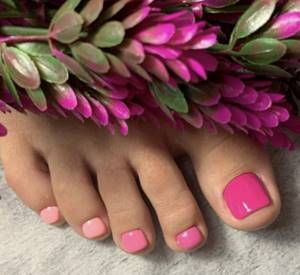
Shoe selection
- Choose comfortable shoes that fit – tight shoes can cause corns and ingrown toenails.
- In the summer, alternate between open and closed shoes: open models prevent the appearance of unpleasant odors and fungal infections, closed ones maintain an ideal pedicure, protecting your feet from dust and sun.
- Buy shoes made from natural materials - such shoes “breathe” themselves and allow your feet to “breathe”.
- Immediately after your nails are coated with varnish, try not to wear closed shoes (unless it is cold outside). The varnish acquires its final hardness within 12 hours; in open shoes it will dry and harden better.
- If corns quickly appear on your feet, consult a podiatrist; you may need to wear orthopedic shoes.
Why does a pedicure go bad?

External deformation of the covering, as well as deterioration of the condition of the feet - the appearance of peeling, keratinization, may be associated with:
- exposure to external factors - dust, temperature changes. This is especially true in the summer, when shoes are open;
- uncomfortable, small shoes . If shoes or sneakers constantly press on your toes, then the pedicure is more likely to not survive its due date;
- physical impact . Toes are more susceptible to bruises, which result in the formation of detachments, leading to premature deterioration of the coating.
Less common causes include:
- violation of technology. After all, you go to a trusted master, which means we exclude this point;
- individual characteristics. “Intolerance” to gel polish and its rejection by the nail plate is an extremely rare phenomenon. It may be related to the structure of the nail plate, its moisture, or some kind of malfunction in the body.
Let's look at two types of pedicure and how to preserve them:
- decorative – gel polish coating;
- hygienic – treatment of feet and fingers.
Do-it-yourself pedicure at home: types of procedures, step-by-step instructions, foot care
Taking care of your health
- Eat foods rich in vitamins A, E, group B - they are responsible for the health of the skin and nails, prevent dryness and flaking of the epidermis, brittleness of the nail plates, and the appearance of corns.
- Include more vegetables, herbs, and dairy products in your diet, but do not give up meat, fish, and cereals.
- If balancing your diet is not possible, take vitamin and mineral complexes designed to promote healthy skin and nails.
- Carefully monitor your personal hygiene - wash your feet, change your socks more often, wash your shoes, do not walk barefoot in public places, do not wear someone else's shoes. If your feet sweat excessively, use powders and deodorants.
- Very dry skin on the feet, deep cracks in the heels can be signs of various diseases, so you need to consult not only a podiatrist, but also other doctors, for example, a therapist, an endocrinologist.
Spend a few minutes every day on your feet and a flawless pedicure will delight you for a long time!
Execution technology
Depending on the method, not only the presence of certain procedures, but also the sequence of steps also differs. For a general idea, you can consider the technique of performing a combined type of pedicure:
- Make a steaming bath and take for 10 minutes. When finished, pat your feet dry with a towel.
- Apply disinfectant solution to your feet.
- Distribute the remover onto problem areas with corns and cracks, and place napkins on top of the product. Wrap your feet in film and leave for 6-10 minutes. Remove the film and remove any remaining remover with a napkin.
- Perform a hardware treatment of the feet using a sanding attachment of medium abrasiveness. After removing calluses and rough spots, take a soft bit and buff the leather until smooth.
- Next, proceed to a classic pedicure. Remove the nail polish and remove the required length using pliers, scissors and a file. Treat the cuticle by moving it or removing it using tweezers. Polish the surface of the nail plate with a soft buff.
- If necessary, degrease your nails and apply a clear base or antifungal agent. After this, you can cover the nail plates with your favorite varnish.
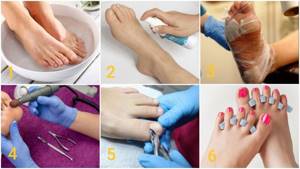
Step-by-step pedicure procedure
Benefits of milk for heels
A milk bath can really have a softening effect. To do this, add just one glass of milk and shavings of baby soap to the basin. The feet are dipped in this solution and held until the water has cooled completely. The benefits of such baths are difficult to overestimate and their effect will delight you for many days. During the bath, you can completely relax in front of the TV screen, read a book, or get a manicure. It is useful to pour glass pebbles on the bottom of the basin and, moving them, as well as stepping on them, perform a simple massage.
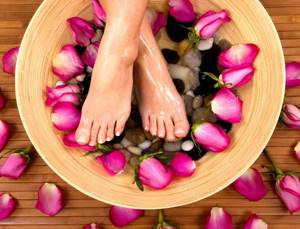
Foot bath with sea pebbles
Prevention
It is possible to get rid of rough skin on the heels, but it is easier to prevent the problem than to deal with its consequences. For prevention purposes, it is recommended:
- Choose gentle abrasives.
- Wear the right shoes (do not purchase products made from synthetic fabrics).
- In the summer, walk more often on grass and pebbles.
- Massage your feet regularly.
- At night, apply a rich cream to soften the epidermis.
- In common areas (sauna, swimming pool, etc.) wear slippers.
- Wash bathroom rugs regularly.
- At least 2-3 times per week. make baths, perform skin scrub treatments (ideally, organize procedures daily).
- At the end of your bath or shower, rinse your feet with cool water.
- After hygiene measures, wipe your feet dry.
- Do not use blades, rough pumice stones or other aggressive abrasives to polish heels.
- After each procedure, nail files and other tools must be disinfected with an alcohol solution or boiling water.
If rough skin and cracks still appear on your heels, you should choose a cream that has a wound-healing effect for treatment. For example, products containing salicylic acid, calendula, urea, propolis, etc.
Traumatic methods of cleaning the feet from rough skin and corns, which involve cutting off the problem area, should be abandoned. This will only cause a defensive reaction, resulting in increased roughness. Gentle methods work better if the procedures are carried out on a regular basis.
Foot massage
A foot massage is a great way to relax and relieve stress at the end of the day. More than 70 thousand nerve endings are concentrated on the foot, the interaction with which directly affects the internal organs. With the help of massage, you can stimulate blood circulation, relieve headaches and swelling, improve sleep and appetite.
There is no magic, just massage techniques are quite strong irritants that provoke the production of acetylcholine in the muscles. Acetylcholine is a substance that is responsible for transmitting nerve signals to muscle tissue and when it is produced during a massage, it quickly relieves heaviness in the legs.
When we press, rub and stroke our legs, the muscle fibers become softer, more mobile, and more elastic. Spasms and tension go away, and thanks to more active blood circulation, cartilage and tendons are strengthened. Interestingly, blood flow improves not only in the feet, but throughout the body. It is useful for the body as a prevention of cardiovascular diseases and blood pressure problems.
Now that you have seen how useful a regular foot massage can be, a few words about the technique of performing it. For a classic massage, you do not need to study the location of acupuncture points, just follow the instructions:
- Warm your hands by rubbing them together, apply massage oil or cream to your feet.
- Start with light stroking movements to relieve tension. Move from your toes to your feet.
- Gradually increase the degree of pressure. Massage the heel in a circular motion and pinch the Achilles tendon.
- If desired, you can go higher by twisting your shin. Avoid painful sensations.
- Gently work the muscles with the edge of your palm.
- At the end of the massage, stroke your feet to relax the nerve endings, and then put on warm socks.
A light foot massage in the evening will effectively relieve tension and help you fall asleep faster.
